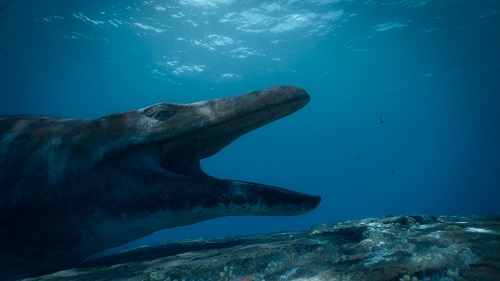Tentacles, bodies and skeletons, oh my! No matter how beautiful or how vital to the history of natural science and life on Earth, some things are just a little freaky. Check out this short list of our top 13 strange, weird and scary artifacts housed in the permanent halls of the Houston Museum of Natural Science.
13. Stone hands
Sculptor Harold van Pelt carved this hand from a solid block of a special mineral. The sculpture is an exact replica of his wife’s hand.
12. Stone skull
Pelt also carved this, a life-sized replica of the human skull, identical to the real thing inside and out. That includes the brain case. The jaw is removable from the skull.
They’re soft and squirmy and have strange, meat-eating mouthparts. These guys aren’t around anymore, but you can get up close and personal to these models based on fossils discovered in Cambrian rock layers. Watch a CG video of them swimming in action alongside trilobites and orthoceras in the Morian Hall of Paleontology.
10. Fossilized sea scorpion pincers
Sea scorpions didn’t always get this big. But when they did, their claws were brutal! Sea scorpions were the apex predator in the Cambrian seas, with a poisonous stinger and these toothy pincers. These in our collection measure about six inches long. Imagine getting pinched by those puppies!
9. A shark that could swallow an elephant
Megalodon, the largest shark to have ever existed, could swallow platybelodon, a mastodon ancestor, in a single bite. Good thing they’re extinct, or whole ships might go missing.
Our preserved specimens of extinct, rare and modern life can be a fascinating walk through taxonomy and the diversity of life on earth. But they’re still treated skins stuffed with cotton. In these specimens, cotton holds the eyes permanently open.
7. Feeding lion
The glass eyes of this preserved lion seem to challenge all who pass. And the severed leg lets us know he means business. What can you say? Life’s hard on the savannah. Keep it real.
This prehistoric mollusk was an ancestor of the modern squid and octopus. In Cambrian rock, their numerous conical shells make this one of the most successful species of the era. And this model, looming overhead, calls to mind that Lovecraftian god of the apocalypse, Cthulhu. (Click the link for Google images if you’re not cool enough to be familiar…)
5. Wall of skulls Nearing the end of the fossil record we find a who’s who of hominids. Homo erectus, australopithecines and Neanderthals included. But it’s pretty disconcerting to stroll around the corner and be confronted by a skull collection of human ancestors staring you in the face.
Nearing the end of the fossil record we find a who’s who of hominids. Homo erectus, australopithecines and Neanderthals included. But it’s pretty disconcerting to stroll around the corner and be confronted by a skull collection of human ancestors staring you in the face.
4. The mummy of General What’s-His-Name
Better than hominid ancestors are those famously well-preserved Egyptian mummies that draw crowds from around the world. This one was a man said to have been a general of the New Kingdom Pharaoh Thutmose III, dating back to 1450 BC. Now that’s an old corpse.
3. The mummy of Neshkhons
I find it more creepy that we know who this body actually was for some reason. Don’t you? This is the mummy of the noble lady Neskhons, who lived during the 21st Dynasty of Egypt, between 1070 and 945 BC. Like many mummies, she was discovered with her most important organs preserved in canopic jars, not including the brain, of course. To ancient Egyptians, the brain was some worthless head-goop.
2. Disembodied head
This mummified head was discovered with a gold-leaf mask, its eyes painted on the outside looking up to the heavens in a symbol of reverence for the gods. The head dates back to between 200 BC and 100 AD.
1. The Aztec god of human sacrifice
 In pre-Columbian Mexico, the Aztec empire stretched for thousands of miles with modern-day Mexico City at its heart. Millions were sacrificed to the god Tlahuizcalpantecuhtli (pronounced tlah-wheeze-call-pan-teh-coot-lee) at the top of the Templo Mayor, the great temple in the middle of the city. Sacrifices were beheaded at the top of a tall flight of steps, and the skulls rolled hundreds of feet down to the city floor. The Aztecs believed the sacrifices kept their food and water plentiful, but the scare tactics also made them the most powerful empire of their time.
In pre-Columbian Mexico, the Aztec empire stretched for thousands of miles with modern-day Mexico City at its heart. Millions were sacrificed to the god Tlahuizcalpantecuhtli (pronounced tlah-wheeze-call-pan-teh-coot-lee) at the top of the Templo Mayor, the great temple in the middle of the city. Sacrifices were beheaded at the top of a tall flight of steps, and the skulls rolled hundreds of feet down to the city floor. The Aztecs believed the sacrifices kept their food and water plentiful, but the scare tactics also made them the most powerful empire of their time.
Come see the freakshow before Halloween, or come in costume to Spirits and Skeletons Halloween night!
#ChillsAtHMNS
















